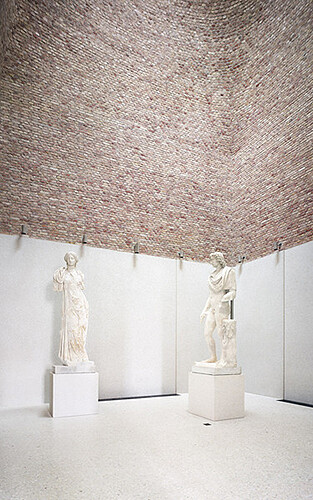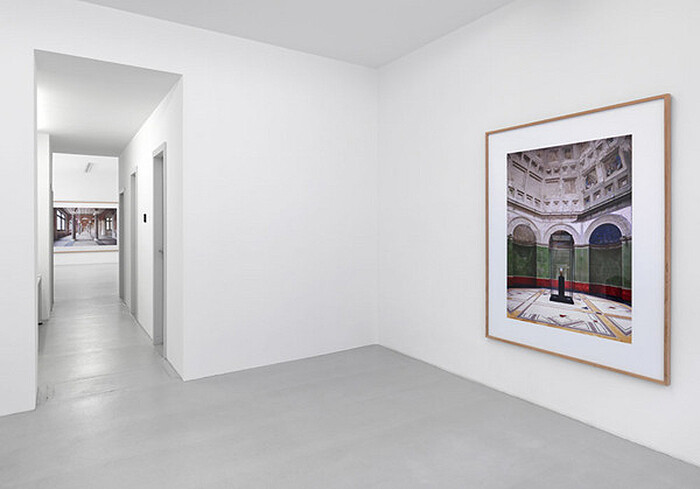What could you possibly say about Candida Höfer that’s not been said before? The German photographer has been around for a long time, doing mostly one thing—shooting apparently flawless, always unpeopled images of monumental public interiors—since her career began in the 1970s.
As distant and calculated as they are breathtakingly detailed and often ornate, Höfer’s oversize photographs depict meticulously composed spaces, indeed, social spaces, such as museums and libraries emptied of their occupants. That’s how her pictures evoke almost ghostly atmospheres. But her methods are predictable—she tends to shoot smaller spaces on the diagonal; larger spaces straight on, and, in the latter case, with the horizon or focal point frequently just below the picture’s center. Her subjects range from the well-visited (the Louvre, Teatro la Scala, MoMA) to the obscure (the Viking Museum of Oslo). She’s big, bold, and Germanically cold, like her cohorts Thomas Ruff, Thomas Struth, and Andreas Gursky; the whole lot of whom studied, of course, at the Düsseldorf Art Academy under Bernd and Hilla Becher.
But we know all of this already. What we didn’t know upon entering Johnen Galerie in Berlin is what her take might be on the Neues Museum, the subject of her newest exhibition here. Would it be more of the same?
A quick background: for 70 years, the Neues Museum [New Museum], a 19th-century neoclassical building on Berlin’s historical Museum Island, was a pile of rubble. Roofless rooms languished for decades. British architect David Chipperfield was commissioned with the renovation, and he combined remnants of the building’s past, like peeling paint and scarred walls, with new architectural elements like sweeping staircases (a controversial approach in a country that generally likes its renovations as smooth and slick as its luxury cars). Höfer shot the works on view at Johnen—six large-scale photographs of the museum interiors—in early 2009, after Chipperfield’s revamp but before the Egyptian, prehistorical, and classical works were returned to the museum, which reopened in October 2009.
In “Neues Museum Berlin,” which just closed, Höfer’s photographs were generously spread over Johnen’s two floors and interspersed with small colorful paintings on chipboard by German painter Raimer Jochims (which are just as spare and strict as Höfer’s works, but which feel and look like flat punctuation marks to her heady statements). The interiors Höfer chose indicate the weight of the Neues Museum’s history, revealing, too, Chipperfield’s choices to meld new and old. Four photographs show elongated halls in which frescoed and colonnaded ceilings and floors converge in a closed door or distant passageway. One image, Neues Museum Berlin VI 2009, is a closer-scale diagonal shot of two statues in a clean white corner under a raw-brick wall, the overhead light source almost divine.
Intriguingly diametrical are the two photographs of the domed space in which the famous bust of Egyptian queen Nefertiti is on display. In Neues Museum Berlin IX 2009 we see Nefertiti’s chiseled face staring expressionlessly at us from a tall glass vitrine in a toplit room whose ceiling and wall frescoes are only half-restored. In the other, Neues Museum Berlin XII 2009, we see what is apparently her sight line (as if we’re looking through Nefertiti’s eyes) out of the same room and into the museum: a seemingly infinite series of spaces that, one thinks, the queen will be looking at forever.
Detractors often argue that Höfer’s work is too stringent and emotionless, that it’s nothing more than architectural photography, that it’s New Objectivity gone tired and old. There are moments in which I half-agree, but the longer I looked at these pictures, the more I realized Höfer’s precision isn’t always so precise: what seems like perfect symmetry often isn’t; her strict use of only natural light, in this case, highlights the imperfections, raw surfaces, and half-renovations that Chipperfield so brilliantly made use of. The exhibition showed something new or at least unusual from Höfer after all: what we’re seeing in the images (from a museum that is incidentally just a few blocks from Johnen Galerie) is the purity that Höfer saw in an ephemeral pre-peopled state. These pictures exert an extraordinary pull; they’re the same, but different, because the artist took a rare opportunity to document a recaptured, reclaimed space before its energies and purpose were muddled by the masses so notably absent and removed, in her other work. They are just as distant, just as monumental as the rest of her oeuvre, but also somehow even blanker and emptier at the same time as richer and fuller, weighted with history yet brand-new.





